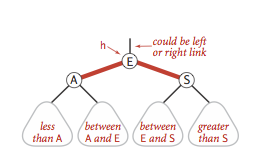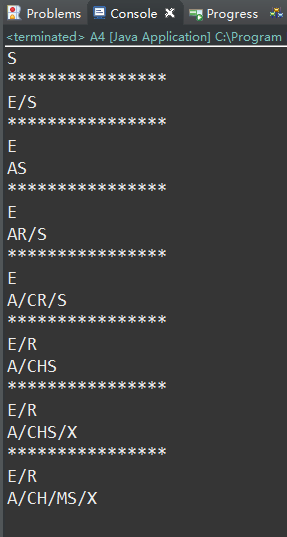实现2-3树的插入有两种方式,一种就是在普通的2-3树上的操作,情况挺复杂的,尤其是在对父节点是3-节点的3-节点进行插入的时候,还要用到临时的4-节点,还有一种就是借用红黑树来实现。
与2-3树一一对应的红黑树
如果红黑树的右节点必须是黑色,而左节点不做要求的话:
1.左节点是黑色,那么此节点对应的就是一个2-节点
2.左节点为红色,那么它与此节点同层,对应3-节点,如图可以很清晰的看出节点之间的对应关系
这样就将一棵2-3树与红黑树相对应起来,就可以借用红黑树的操作了
正儿八经2-3树的插入过程
在进行插入操作时,要时时刻刻维持树的平衡,比如出现这种狗样子的树:
这三种情况是明显不符合2-3树的气质的,要进行相应的旋转变色操作变成下面这三种:
正儿八经2-3树的代码
两部分,这部分是2-3树的插入的实现,第二部分为相应的测试代码
package algorithm;
/*********************************************
* A4.java
* Author: jkbao
* Created on: 2018年4月18日
********************************************/
import java.util.LinkedList;
import java.util.Queue;
public class A4 {
private Node root;
private static final boolean RED = true;
private static final boolean BLACK = false;
private class Node {
Object val;
Node left, right;
// int N;
boolean color;
Node(Object val, boolean color) {
this.val = val;
// this.N = N;
this.color = color;
}
}
private boolean isRed(Node x) {
if (x == null)
return false;
return x.color == RED;
}
private Node rotateLeft(Node h) {
Node x = h.right;
h.right = x.left;
x.left = h;
x.color = h.color;
h.color = RED;
return x;
}
private Node rotateRight(Node h) {
Node x = h.left;
h.left = x.right;
x.right = h;
x.color = h.color;
h.color = RED;
return x;
}
private void filpColors(Node h) {
h.color = RED;
h.left.color = BLACK;
h.right.color = BLACK;
}
public void put(Object val) {
root = put(root, val);
root.color = BLACK;
}
private Node put(Node h, Object val) {
if (h == null)
return new Node(val, RED);
if ((int) val < (int) h.val) {
h.left = put(h.left, val);
// System.out.println((int)h.val);
// System.out.println((int)h.left.val);
} else if ((int) val > (int) h.val)
h.right = put(h.right, val);
if (isRed(h.right) && !isRed(h.left))
h = rotateLeft(h);
if (isRed(h.left) && isRed(h.left.left))
h = rotateRight(h);
if (isRed(h.left) && isRed(h.right))
filpColors(h);
return h;
}
第一部分到这里结束,关键的就是put方法的实现,其实在二叉平衡树里面这个方法的实现都差不多,不同的是在递归调用put方法之后的相应的旋转变色操作。
第二部分,以序列 { 'S', 'E', 'A', 'R', 'C', 'H', 'X', 'M' } 为例,一步步打印出二叉树节点的插入过程,打印的实现用了广度优先遍历算法,分层打印的实现也用到了一个小技巧。
正儿八经测试的代码
public static void main(String args[]) {
char arr[] = { 'S', 'E', 'A', 'R', 'C', 'H', 'X', 'M' };
A4 a = new A4();
a.put((int) arr[0]);
for (int i = 1; i < arr.length; i++) {
//System.out.println(a.level(a.root));
a.bfs(a.root);
System.out.println("****************");
a.put((int) arr[i]);
}
// System.out.println(a.level(a.root));
a.bfs(a.root);
}
public int level(Node no) {
if (no == null) {
return 0;
}
if (no.color == BLACK)
return 1 + level(no.right);
return level(no.right);
}
public void bfs(Node rootNode) {
Queue<Node> queue = new LinkedList<>();
if (rootNode == null)
return;
if (root.left != null && root.left.color == RED)
queue.offer(root.left);
queue.offer(rootNode);
//这个队列用于分层打印的实现
Queue<Node> tempQue = new LinkedList<>();
while (!queue.isEmpty()) {
Node node = queue.poll();
System.out.print((char) (int) node.val);
if (node.color == RED)
System.out.print("/");
if (node.color == RED) {
if (node.left != null && node.left.left != null && node.left.left.color == RED)
tempQue.offer(node.left.left);
if (node.left != null)
tempQue.offer(node.left);
if (node.right != null && node.right.left != null && node.right.left.color == RED)
tempQue.offer(node.right.left);
if (node.right != null)
tempQue.offer(node.right);
} else {
if (node.left != null && node.left.color == BLACK) {
if (node.left.left != null && node.left.left.color == RED) {
tempQue.offer(node.left.left);
}
tempQue.offer(node.left);
}
if (node.right != null && node.right.left != null && node.right.left.color == RED)
tempQue.offer(node.right.left);
if (node.right != null)
tempQue.offer(node.right);
}
//队列为空说明这一层打印完了
if (queue.isEmpty()) {
System.out.println();
queue = tempQue;
tempQue = new LinkedList<>();
}
}
}
}
正儿八经的测试结果比对
插入过程图 vs 测试结果图(E/ 为红色(节点后面有个斜杠就是红色),S为黑色(没有斜杠))









